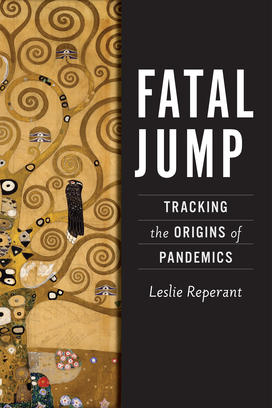Leslie Reperant *10 Investigates Virus Spread in New Book
The book: In Fatal Jump (Johns Hopkins University Press) author Leslie Reperant *10 explores the chain of events that leads to life-altering infectious diseases and pandemics. While very few pathogens result in catastrophic chains of transmission, some do, and Reperant wants to understand why. In addition to the COVID-19 pandemic, she investigates other examples of contagious spread including monkeypox outbreaks and the Nipah virus. Through research, scientific discoveries and emerging theories, Fatal Jump explores what it will take to predict future pandemics and what actions are necessary to prepare.

The author: Leslie Reperant is the founder and director of Pikado B.V., a company that offers scientific writing and editing services. She earned her doctorate in veterinary medicine from the Veterinary School of Lyon, France, and her Ph.D. in ecology and evolutionary biology from Princeton. Her studies have focused on the interplay between pathogenesis and evolutionary influenza virus, and the factors that drive viral spread. Her work has been published in The Lancet and Science, among other scientific journals.
Excerpt:
Infectious diseases. Contagions. They spread from person to person. They sow death and suffering. In our eternal fight against them, we have successfully annihilated two of the worst scourges: smallpox in humans and rinderpest, the equivalent of measles in cattle. Unfortunately, many other scourges repeatedly escape our control—emerging or reemerging—despite our sustained efforts to stall them.
When confronted with infectious diseases and their medical burdens, we often curse their existence. However, infectious diseases are an integral outcome of the large and abundant set of parasitic interactions of the living world, and parasitism has vast ramifications that extend across the branches of the Tree of Life in the most unexpected ways. Some of these ramifications may teach us a thing or two about the circumstances that have led to (and continue to feed) our never-ending battle against infectious plagues of all sorts. Undoubtedly, they can teach us how to successfully tackle our microbial foes.
Microbes are tiny, invisible to the naked eye, but their impact can be immense. Microbes include viruses, bacteria, microfungi (like molds, mildews, and rusts), and single-celled protists. They are not all pathogens, and their lifestyles are diverse. Apart from viruses, many microbes are “free-living” species, spending their “independent” lives in the soil or in water. Some microbes are commensals or even mutualists; in other words, they are neutrally or even beneficially—if not indispensably—associated with other living organisms. The “microbiome” and “microbiota” have become trendy since the versatile benefits of the microbes living on or inside us have come under the spotlight of the health sciences.
Other microbes have evolved into parasites: organisms that live with, on, or inside another organism, with negative or harmful consequences for that host. A pathogen is a microbial agent of disease and is largely an equivalent term to microparasite.
Remarkably, the diversity of lifestyles among the microbes is not much different from what we observe among the animal, fungus, and plant kingdoms. Many animals, fungi, and plants are typically what we envision of free-living species. Some are (largely) “neutral” commensals, such as the crop-associated weeds, house mice, and rock pigeons that live along with us. Others are beneficial mutualists, a classic example being sea anemones and clownfish. A less familiar one may be myrmecophytes, tropical plants that form beneficial relationships with colonies of ants.
Like microbes, some animals, fungi, and plants have evolved into parasites. Think of parasitic worms (or helminths) and parasitic arthropods (e.g., lice, fleas, and ticks). There are also parasitic mollusks (e.g., certain sea snails living off corals or on sea cucumbers), parasitic fish (e.g., lampreys, the eel-like jawless fish that attach themselves to other fish and suck their blood), parasitic birds (masters in the art of brood parasitism, e.g., cuckoos and cowbirds), parasitic fungi (e.g., some shelf fungi on live tree trunks), and parasitic plants (e.g., mistletoe, dodder, and monster flowers). Vampire bats, the leaf-nosed bats of Central and South America, which feed exclusively on blood of other warm-blooded animals, are the only parasitic mammals known to date—that is, if we exclude the eclectic diversity of kleptoparasites, animals that steal food or other resources from other animals.
Parasitism is one of the most common lifestyles on Earth, with at least half and perhaps as much as 90% of all species qualifying as parasites. Parasitism is part of the set of symbiotic interactions that characterize intimate associations between species. Contrary to popular belief, a symbiosis does not necessarily entail mutual benefits; it simply refers to “living closely together.” The outcome of a symbiosis isn’t set in stone either: it doesn’t invariably result in negative (parasitism), largely neutral (commensalism), or positive consequences (mutualism) for the host. The distinction is rarely clear cut. These associations form a continuum, with many symbioses shifting their outcome along the gradient in response to different ecological circumstances. Symbiotic associations once yielding benefits can turn into misfortunes, and vice versa.
Symbiosis is an elaborate game of intricacies, and it is ubiquitous and ancient. Genetic parasitism and processes similar to viral infection may have ignited life’s debut, in a geological maze of biochemical reactions. Key yet conflicting symbiotic events of the distant past have been instrumental to the extraordinary origin and thriving of the Eukaryota, or complex life, to which you and I belong. You may understandably wonder whether there is more to parasitic associations than discomfort and sorrow. If I graphically described the life cycle of the tapeworm, the reproductive cycles of Plasmodium falciparum in the mosquito and human hosts—causing malaria—or the pathogenesis of a severe flu infection deep in the lungs of a young infant with pneumonia, you might react with aversion, horror, and indignation, all aimed at parasitism and certainly for valid reasons. Taken on their own, the resulting diseases appear as malfunctioning aberrations, inanimate, to be targeted by treatment or, better yet, by prophylaxis aimed at preventing disease in the first place.
And yet, despite our abhorrence of disease-causing organisms, context proves of prime importance in many a story told. Context often provides valuable insights into adapted responses to identified issues. The context of this book—surrounding parasites, pathogens, plagues, and pandemics—is nothing less than the awe-inspiring cogs and gears of Nature herself.
…
Ever since the 1940s, the number of emerging infectious diseases that affect us has never ceased to climb. In the past few months alone, unsettling reports of mpox, Ebola, Marburg, bird flu have multiplied, succeeding the now dwindling news updates on the COVID-19 pandemic. These ailments earned the moniker of “emerging diseases” because their causative agents are in the process of invading new host species for the first time, or their incidence is increasing, or their geographical range is expanding. Our modern technologies and improved surveillance likely are picking up parasites and pathogens that had previously escaped our attention. Thus, we must remain cautious with any claim of infectious diseases emerging “for the first time.” However, even when controlling for such a bias, studies are unanimous: the pace of disease emergence is accelerating.
At the human scale, poverty, insufficient hygiene, civil unrest, wars, famine, and other upheavals have been most conducive to human disease eruption and spread. These triggers are in the background whenever we see “old” diseases of the past resurface. Pervasive triggers that act at the interface of our expanding niche—our engineered human habitat—and the natural world have been at the origin of most “newly” emerging plagues.
…
Preserving human health from emerging infectious diseases is best addressed by targeting emerging pathogens at their source. The most challenging issue is to grasp the nature of the source.
The identification of the animal reservoir of a zoonotic pathogen (or a pathogen bearing high economic costs) often prompts the visceral culling response—the very same response humans have launched on predators attacking game and livestock—with little regard for ethical implications and knock-on ecological impact. This response is still preferentially applied to break the spread of a pathogen introduced into domestic or farmed species.
The culling of wild reservoirs has been attempted for bovine tuberculosis, rabies, Marburg: more often than not, it has brought counterproductive results, essentially because the movement and intermingling of wild animals cannot be simultaneously controlled. On the contrary, the removal of individuals in the wild promotes movement and interactions, as territories left vacant are recolonized, fueling disease transmission.
In 2008, miners in southern Uganda trapped the tens of thousands of Egyptian fruit bats that inhabited the gold mine using fishing nets draped over the exits. They exterminated the colony that had been implicated in the transmission of marburgviruses to miners. Four years later, the largest Ugandan epidemic of Marburg broke out in a nearby town. A small colony of Egyptian fruit bats had recolonized the mine. It was less than 5% the size of the colony before the depopulation efforts; the number of active marburgvirus infections among them was over twice as high.
The source of Marburg, Nipah, and other bat-borne disease outbreaks is not bats. It is deforestation, natural habitat loss, the human encroachment of bat habitat, and their cascading consequences. The source of zoonotic diseases originating from domestic or (wild) farmed animals is not the implicated species; it is the undignified, overcrowded, and unsanitary conditions plaguing industrial farming.
Emerging infectious diseases are another symptom of humanity’s inequalities and of our planet’s ecological degradation. Acting to address the root causes of the threats posed by emerging pathogens form the core of One Health, whereby human, animal, plant, ecosystem, and planetary health are recognized as interconnected. Preserving one needs preserving the others; preserving one is preserving the others. One Health can only grow out of humanity’s global ecological consciousness.
Excerpted from Fatal Jump: Tracking the Origins of Pandemics by Leslie Reperant. Copyright 2023. Published with permission of Johns Hopkins University Press.
Reviews:
“Leslie Reperant's book eloquently brings together threads from many different areas of biology, epidemiology, and veterinary science. She creates a marvelous tapestry to show how pathogens emerge, get established, and spread in host populations.” — Andy Dobson, professor of ecology and evolutionary biology at Princeton University
“An intriguing account of the complex interaction between pathogens and us, through deep history to now and COVID-19. The narrative probes issues with evolution, discusses our defense mechanisms, and looks at how viruses in particular jump from other warm-blooded vertebrates into us. This is an easy, informative, and interesting read.” — Peter Doherty, immunologist












No responses yet